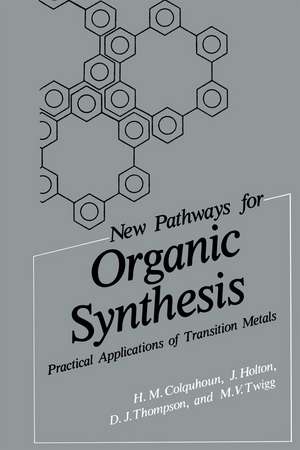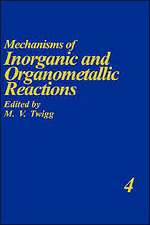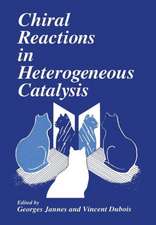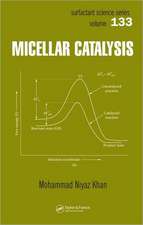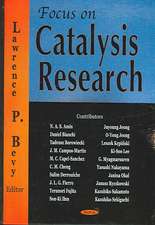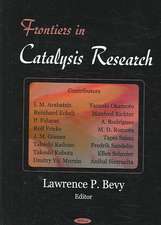New Pathways for Organic Synthesis: Practical Applications of Transition Metals
Autor H.M. Colquhoun, J. Holton, D.J. Thompson, M.V. Twiggen Limba Engleză Paperback – oct 2011
Preț: 397.01 lei
Nou
Puncte Express: 596
Preț estimativ în valută:
75.99€ • 78.31$ • 64.15£
75.99€ • 78.31$ • 64.15£
Carte tipărită la comandă
Livrare economică 03-17 martie
Preluare comenzi: 021 569.72.76
Specificații
ISBN-13: 9781461296539
ISBN-10: 1461296536
Pagini: 472
Ilustrații: 468 p.
Dimensiuni: 152 x 229 x 25 mm
Greutate: 0.63 kg
Ediția:Softcover reprint of the original 1st ed. 1984
Editura: Springer Us
Colecția Springer
Locul publicării:New York, NY, United States
ISBN-10: 1461296536
Pagini: 472
Ilustrații: 468 p.
Dimensiuni: 152 x 229 x 25 mm
Greutate: 0.63 kg
Ediția:Softcover reprint of the original 1st ed. 1984
Editura: Springer Us
Colecția Springer
Locul publicării:New York, NY, United States
Public țintă
ResearchCuprins
1. Introduction.- 2. Formation of Carbon—Carbon Bonds.- 2.1. Formation of Carbon—Carbon Single Bonds.- 2.2. Formation of Carbon—Carbon Double Bonds.- 3. Formation of Carbocyclic Compounds.- 3.1. Introduction.- 3.2. Formation of Three-Membered Rings.- 3.3. Formation of Four-Membered Rings.- 3.4. Formation of Five-Membered Rings.- 3.5. Formation of Six-Membered Rings.- 3.6. Formation of Seven-Membered Rings.- 3.7. Formation of Eight-Membered Rings.- 3.8. Formation of Large Rings (?9).- 4. Formation of Heterocyclic Compounds.- 4.1. Introduction.- 4.2. Nitrogen Heterocycles.- 4.3. Oxygen Heterocycles.- 4.4. Sulfur Heterocycles.- 4.5. Cyclic Compounds Containing Two Hetero Atoms.- 5. Isomerization of Alkenes.- 5.1. Introduction.- 5.2. Thermodynamic Considerations.- 5.3. Isolation of Organometallic Intermediates.- 5.4. Mechanisms of Catalytic Alkene Isomerization.- 5.5. Formation of a,?-Unsaturated Compounds.- 5.6. Formation of Conjugated Dienes.- 5.7. Migration into Conjugation with Aromatic Rings.- 5.8. Formation of Aromatic Compounds—Isoaromatization.- 6. Direct Introduction and Removal of Carbonyl Groups.- 6.1. Preliminaries.- 6.2. Preparation of Carboxylic Acids, Esters, and Related Derivatives.- 6.3. Preparation of Aldehydes.- 6.4. Preparation of Ketones.- 6.5. Preparation of Isocyanates.- 6.6. Decarbonylation of Aldehydes and Acyl Halides.- 7. Reduction.- 7.1. Introduction.- 7.2. Reduction of Triple Bonds.- 7.3. Reduction of Double Bonds (Nonaromatic).- 7.4. Reduction of Aromatic Systems.- 7.5. Reduction of Carbonyl Groups.- 7.6. Reduction of Nitro, Nitrile, and Other Nitrogen-Containing Functional Groups.- 7.7. Asymmetric Hydrogenation.- 7.8. Hydrogenolysis.- 8. Oxidation.- 8.1. Formation of Alcohols.- 8.2. Formation of 1,2 Diols and Amino Alcohols.- 8.3.Acetoxylation.- 8.4. Epoxidation.- 8.5. Formation of Aldehydes and Ketones.- 8.6. Formation of Acids.- 8.7. Formation of Esters.- 8.8. Dehydrogenation.- 9. Preparing and Handling Transition Metal Catalysts.- 9.1. Introduction.- 9.2. Preparation of Catalysts.- 9.3. Metal Acetylacetonates.- 9.4. Arene Metal Tricarbonyls—ArM(CO)3 (M = Cr, Mo, or W).- 9.5. Transition Metal Carbonyls.- 9.6. Recovery of Precious Metals.- 9.7. Handling Air-Sensitive Compounds.- References.- Compound Index.
